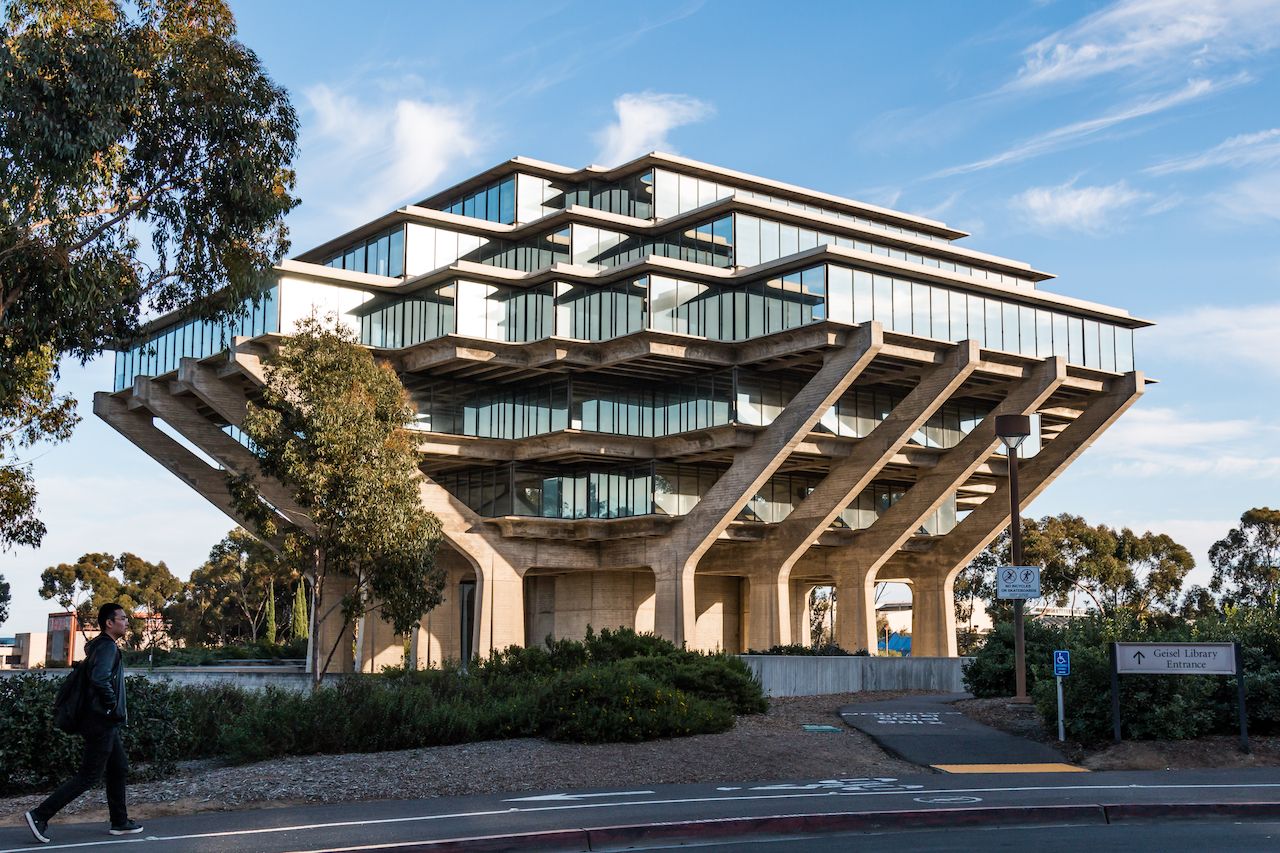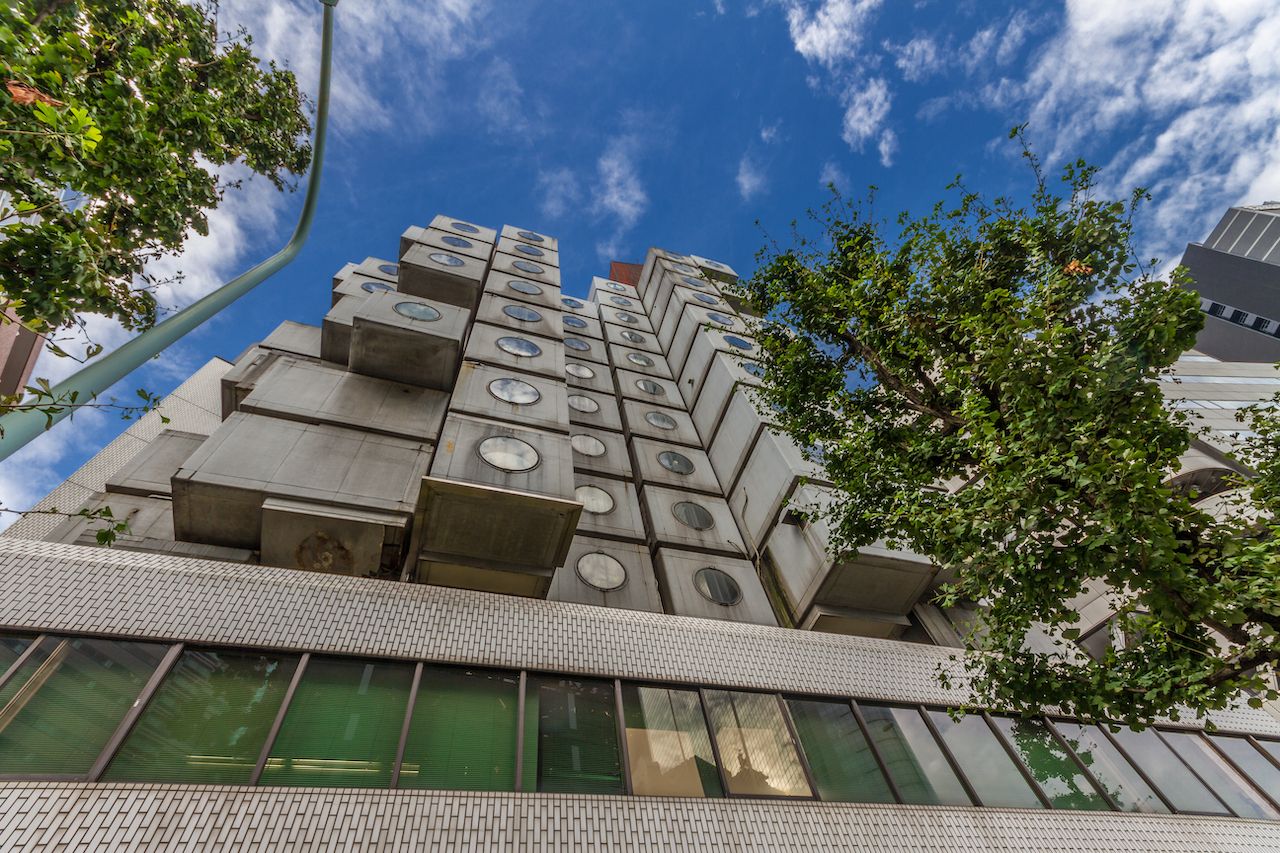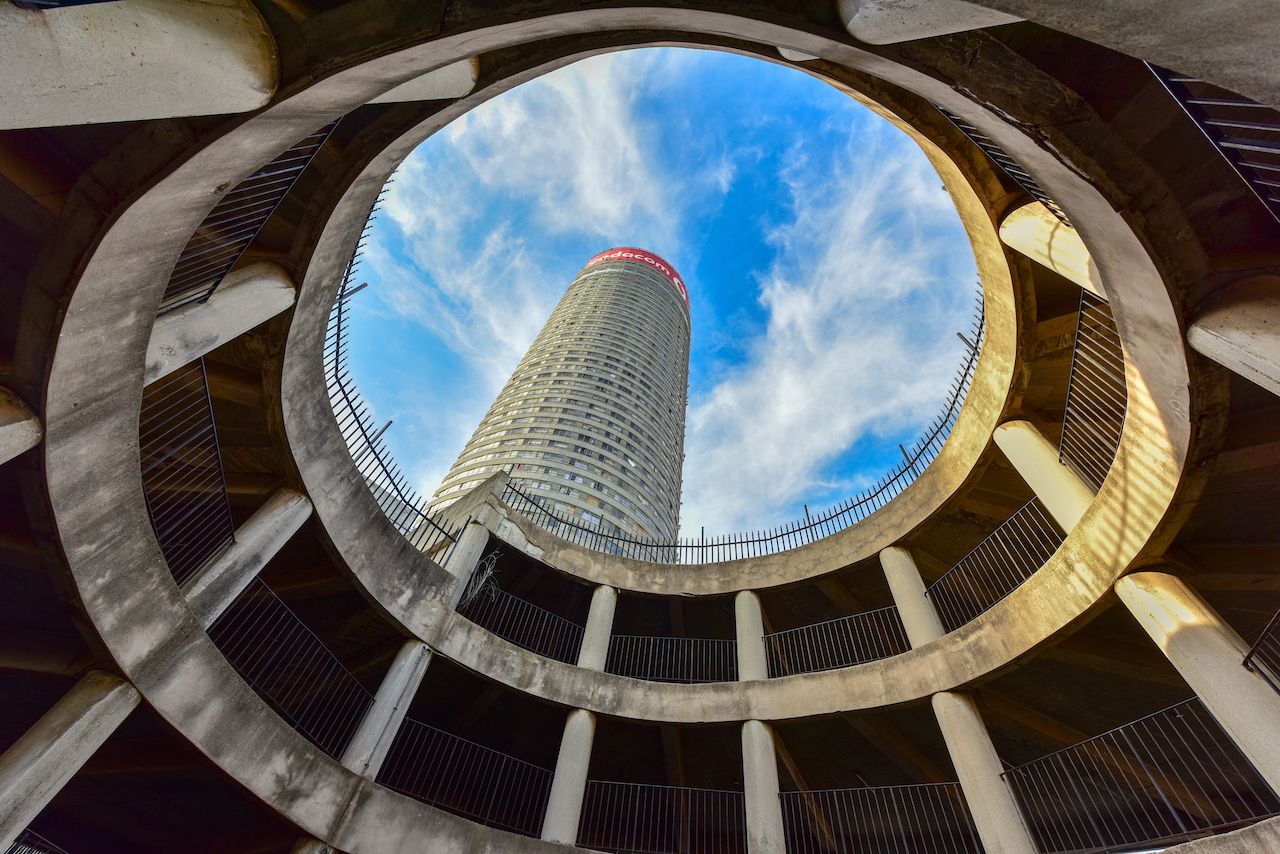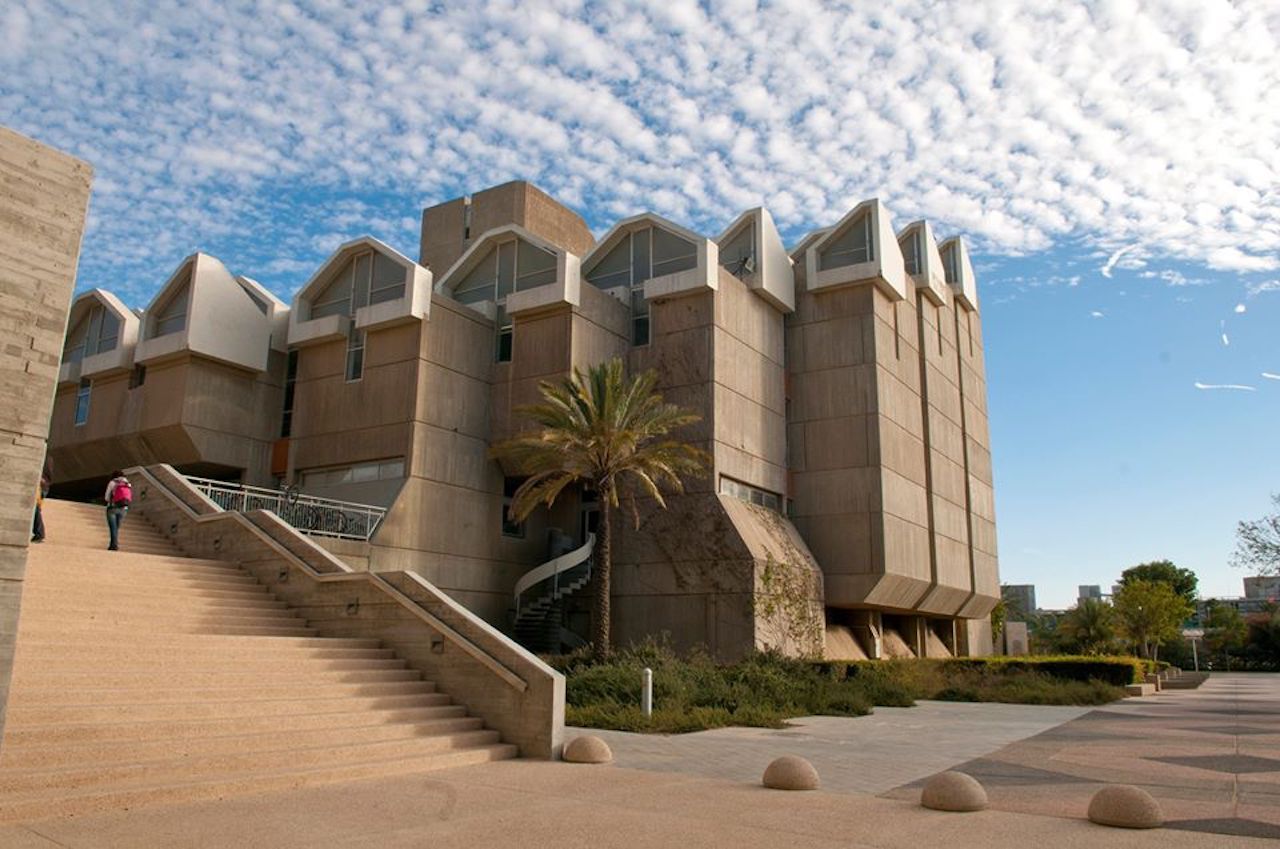Along with the worldwide call for a more socialist approach to society and government, so has interest risen in Brutalism: a style of architecture that emerged first in post-war Europe. Though normally associated with communist East Germany and the USSR, Brutalism flourished throughout the world as it presented an economical way to produce grand buildings. Many countries took advantage, specifically for government or public spaces, and lots of the masterpieces of this era are still standing today. For travelers interested in Brutalism, there’s no need to relegate yourself to Eastern Europe and Russia; in fact, you may be able to find an example in your own backyard. If you’re not sure where to start, here are a few shining examples of Brutalism scattered all over the world.

8 Marvels of Brutalist Architecture From Around the World
1. Geisel Library, La Jolla, California

Photo: Sherry V Smith/Shutterstock
The Geisel Library, still the main operational library at the University of California San Diego, opened in 1970 as the Central Library. It was designed by William Pereira, a Chicagoan by birth who later made La Jolla his home. Pereira was an extremely prolific designer and had over 400 major projects to his name by the time of his death in 1985, though he is possibly best known as designing San Francisco’s Transamerica Pyramid. His work on the Geisel Library was the highlight of a design aesthetic that he spent his lifetime perfecting — one born of resolving humble, ecumenical materials into dazzling works.
Upon a mild renovation in 1993 it was briefly renamed the University Library, but it wasn’t until 1995 that it was finally given the name it still bears today to honor a long-time friend of the University, Theodor Seuss Geisel. As well as an act of appreciation for a number of sizable donations Seuss-Geisel had granted to the library over the years, the posthumous renaming of the library also intended to honor his absolute allegiance to tackling illiteracy, particularly among children. In his lifetime, Seuss-Geisel won an Oscar, an Emmy, and a Pulitzer, on top of publishing over 60 children’s books, of which he sold over 600 million copies. Though many don’t recognize the name Theodore Seuss-Geisel, his books have been translated into over 20 languages, and one of his many pen-names is recognized around the world: Dr. Seuss.
If you visit the library today, be sure you pay a visit to the Mandeville Special Collections and Archives, home of the Dr. Seuss Collection. This exhibit features hundreds of items from Seuss-Geisel’s long, prolific career and includes original drafts of his manuscripts, drawings, taped recordings, and lots of other assorted memorabilia totaling over 8,000 items. The collection has items as old as over a hundred years, though some were created as recently as 1991, just before his death.
2. Nakagin Capsule Tower, Tokyo, Japan

Photo: Manuel Ascanio/Shutterstock
Designed by architect Kisho Kurokawa and erected in just 30 days in 1972, The Nakagin Capsule Tower was created to be a residential building for Tokyo’s salarymen. The reinforced concrete frame contains 140 prefabricated pods that were individually craned into place. This meant that over the course of the towers’ intended life, the pods could, in theory, be renovated, replaced, and even combined to create larger, more permanent living spaces. Unfortunately for Kurokawa, his intentions for the tower were never quite realized: Though each capsule was intended to last about 25 years before requiring replacement, none of the capsules — nor the concrete frame — have ever been replaced or structurally refurbished in its nearly 60-year lifespan. But despite the building’s clear signs of decay, by the grace of some interesting tenant laws in Tokyo, the tower still stands in defiance to the much newer, much taller contemporary skyscrapers that now stand around it on the edge of the Ginza neighborhood.
Though it has faced near-demolition several times over the years, Tokyo resident Tatsuyuki Maeda has spearheaded current preservation efforts and himself owns 15 capsules. He is motivated by the realization that life in 2020 and beyond has finally embraced a lifestyle that Nakagin aimed to glorify; in a new world of tiny houses and #vanlife, the lessons of Nakagin’s cocoon-like living spaces may be more important than ever. Though Nakagin’s fate is still uncertain, Maeda is confident that the tower can be restored, most likely via private funding. The Japanese government, specifically those in charge of the preservation of post-war and modernist architecture in the country, has accomplished little to preserve this rich design heritage. “The preservation of modern architecture is basically a failure,” Maeda said. “Japan is inevitably trapped in a scrap-and-build culture.”
Though visitors to the tower cannot expect to get past the lobby by simply turning up, you can arrange a tour in advance, the proceeds of which go directly to the Nakagin Capsule Tower Preservation & Restoration Project, which aims to restore the building to its former glory thus fulfilling the dream of its creator. If you’ve always wanted to see Nakagin, please hesitate no longer: If Maeda is unsuccessful in securing private investment, it could be demolished as early as this year.
3. Marina City, Chicago, Illinois

Photo: BorisVetshev/Shutterstock
Possibly the most successful of Bertrand Goldberg’s many architectural projects, the Marina City Towers still stand today a much-admired residential address just north of the Chicago Loop and were the tallest concrete structures in the world at the time. It is generally considered the first major gentrifying project in the United States as it attracted upper-class clientele back into Chicago’s inner city. First opened in 1963, it originally housed an ice skating rink, a bowling alley, and a theater. It also had a small marina for the residents’ watercraft for which the towers got their name.
Lovingly known as the “corn cobs” by Chicagoans, Marina City became an instant landmark, mainly because of its unique design of petal-like scalloped outcrops stacked down their length. But in pure Brutalist fashion, these design elements serve the purpose of providing every single apartment with at least one balcony, regardless of the square footage inside. Because they have retained their popularity since they were constructed, the building and respective units have been appropriately maintained, and you can still rent a plainly refurbished unit in the building for as little as $1,400 a month.
Visitors today won’t find the original marina or ice skating rink, though you may be pleased to find the iconic concert hall, The House of Blues. Although there is not currently a company that offers tours of the units inside the building, prospective tenants can schedule a viewing of available rentals with a realtor. But window-shoppers beware: The views from the towers are notoriously intoxicating. A single visit to one of those iconic semi-circular balconies, and you could easily find yourself swiftly relocating to Chicago.
4. Ponte City Apartments, Johannesburg, South Africa

Photo: Felix Lipov/Shutterstock
Ponte, as it is frequently called for short by Joburgers, is a building of extremes. Located on the edge of the Berea neighborhood by the M3 highway, Ponte stands just next to the notorious Hillbrow and to this day, some 45 years after its completion, is still the tallest residential skyscraper on the African continent. Atop its 55 stories is the single largest neon sign in the southern hemisphere, which currently advertises for telecommunications company Vodacom.
Originally intended for wealthy, white Afrikaners and transplant Europeans, an address at the Ponte was once much admired given its sweeping views of the city. But the beginning of the ‘90s, in anticipation of the fall of Apartheid, Ponte and its adjacent neighborhoods began slowly filling with black residents in radical protest to the laws that prevented them from occupying the neighborhood. With the fall of Apartheid, so went the white stronghold of Hillbrow, and the adjacent Ponte spent the next several years falling into miserable decay.
For better or for worse, a revivification project began on the iconic building in the year 2000 and has since been refurbishing units, overhauling the infrastructure of the building, and even cleaning out the five stories of trash that had accumulated in its hollow core. Though many long-time black residents have been forced out due to recently escalating rents, the Ponte is entering a new renaissance and is once more taking its place as one of the most iconic buildings in the world.
It is notoriously difficult to visit Ponte as a non-resident: Lessees describe living there akin to living at a boarding house and have even been forced to pay a fee to have overnight guests. But if you’re dying to snap that iconic photo from the floor of its hollow core for the ‘gram, you can schedule a tour with Dlala Nje. This NGO also hosts The Ponte City Challenge every few months, wherein participants climb to the top of the Ponte — yes, up all 900-plus stairs and 54 stories — completely on foot.
5. The Zalman Aranne Library, Beersheba, Israel

Photo: ספריית ארן/Facebook
On the campus of the Ben-Gurion University of the Negev, you’ll find the Aranne Library, the joint project of five different Israeli architects. While the campus houses many magnificent architectural examples, the library stands out as a Brutalist icon having successfully reconciled the principles of Brutalist design with the principles of Brutalist function into one seemingly effortlessly constructed building.
The ethos of the building’s design aims to solve a couple of elemental problems: making a public space feel private while still providing natural light for all visiting readers. Its design utilizes the abundance of sunshine in the region but, to avoid direct glare, angles it’s triumphant windows to the north. The resulting sunlight spills into all of the appointed reading areas: a series of nooks and balconies that are scattered throughout that connect to or overlook the main common area. The outcome makes the interior just as impressive as the exterior and can allow hundreds of individuals to feel completely alone in the expansive and popular space.
Although a bit out of the way for many visitors to Israel and Palestine, those headed on a road trip to the notoriously tax-free city of Eilat from Tel Aviv will find the University an easy pit stop.
6. Sirius Block Apartments, Sydney, Australia

Photo: Leonid Andronov/Shutterstock
Barnaby Bennett, creative director of the 13th annual Sydney Architecture Festival, says that Sydney’s real estate market “exemplifies urban problems of affordability: houses are too expensive, homelessness is rising, the construction industry is struggling to keep up with demand, and we are still largely building the wrong type of houses in the wrong places.” In a city with some of the most unaffordable housing in the entire world, many are surprised to hear that from 1979 to 2018, The Sirius Building served as public housing in the extraordinarily desirable Rocks District and that units came replete with picturesque views of Sydney Opera House and Harbour Bridge.
Designed by Tao Gofers for the Housing Commission of New South Wales, it may be the finest example of Brutalist ethical design — an aesthetic that stems from the idea that it is the responsibility of designers and constructors to resolve the limitations of inexpensive materials into glorious structures — the end result ideally being that even people with limited means have the ability to live somewhere beautiful and comfortable. But this dream, unfortunately, wouldn’t last long — the housing commission put it on the market in 2018, eventually selling it to Sirius Developments for $150 million Australian dollars.
Thankfully, they have employed BVN to herald the refurbishment project, whose principal, Phillip Rossington, said, “We were only interested in the project if the building was retained,” which is a victory for those who adore the design of this famous apartment block. However, the project comes at a huge loss to the surrounding community — once staunchly working-class — as there will be no outright provision to retain any portion of the units as public or affordable housing.
Though BVN plans on eventually establishing it as a mixed-use building incorporating retail shops on the ground floor, visitors today will find a much less accommodating atmosphere. The only people currently found on the grounds are security guards hired to prevent journalists — and tourists — from entering the building.
7. Freeway Park, Seattle, Washington

Photo: Seattle.gov
Though not a building at all — rather an urban park composed of concrete, trees, and greenery — Freeway Park nonetheless remains a Brutalist masterpiece. Built under the supervision of Bulgarian landscape architect Angela Danadjieva, it first opened to the public on the United States’ 200th Independence Day: July 4, 1976. Literally built atop portions of I5 as it snakes through downtown Seattle, it also incorporates several water features throughout its many climbable, terraced concrete structures, most notably, Naramore Fountain by renowned sculptor George Tsutakawa.
Unfortunately, the very elements of its design that made it so cool were the exact same elements that brought crime to the park. Its interwoven concrete blocks that eventually became so gorgeously filled with vegetation created nooks and crannies that so easily shrouded illicit activity. Though it long had a reputation for housing general petty crime, a 2002 murder in the park sparked a concerted effort between the parks department and the Freeway Park Neighborhood Association to address how the design of the park contributed to such activity. Thankfully, as many citizens were vocal in their demands for a drastic redesign, crime in the park was reduced by 90 percent in three years simply by increasing patrols, and improving lighting.
Visitors today will find it even lovelier than when it was first opened in 1976, as the vegetation has had a chance to mature, giving it the feel of a modern relic. The park is ringed by hotels and sits just adjacent to the Convention Center, so many visitors the city find it by sheer accident. But if you’re staying a bit farther away, do yourself the favor and make a special trip; it’s accessible by light rail, and you won’t be disappointed.
8. The Bank of Guatemala Building, Guatemala City, Guatemala

Photo: Byron Ortiz/Shutterstock
Of the most iconic buildings in Guatemala City, the Bank of Guatemala building was constructed by José Montes Córdova and Raúl Minondo in 1966. Seated in the first zone of the city in the civic center, its place in the Brutalist cannon also relies distinctly on the arguably non-Brutalist addition of the murals on the east and west facades created by Guatemalan artists Dagoberto Vásquez Castañeda and Roberto González Goyri respectively.
While these murals in some ways eschew the principles of Brutalism as their design serves no direct function, their construction in molded concrete certainly highlights Brutalist reliance on accessible, contemporary materials. In a nod to their proposed longevity, these murals rely on light and shadow to apply highlight and contrast to the works, meaning that their appearance changes slightly throughout the day. The Mayan imagery depicted was chosen not just to be a public testament to the history of Guatemala but also to highlight Guatemalans as part of the Brutalist movement, as many examples of Brutalism in Latin America were actually designed by Europeans or Americans.
The building is still the operational home of the National Bank of Guatemala, so you can go see it today. If you do, try and get a peek of the mezzanine indoors — the murals that adorn its exterior were made to complement some details of the already constructed interior, specifically those you will find surrounding the elevator bank.